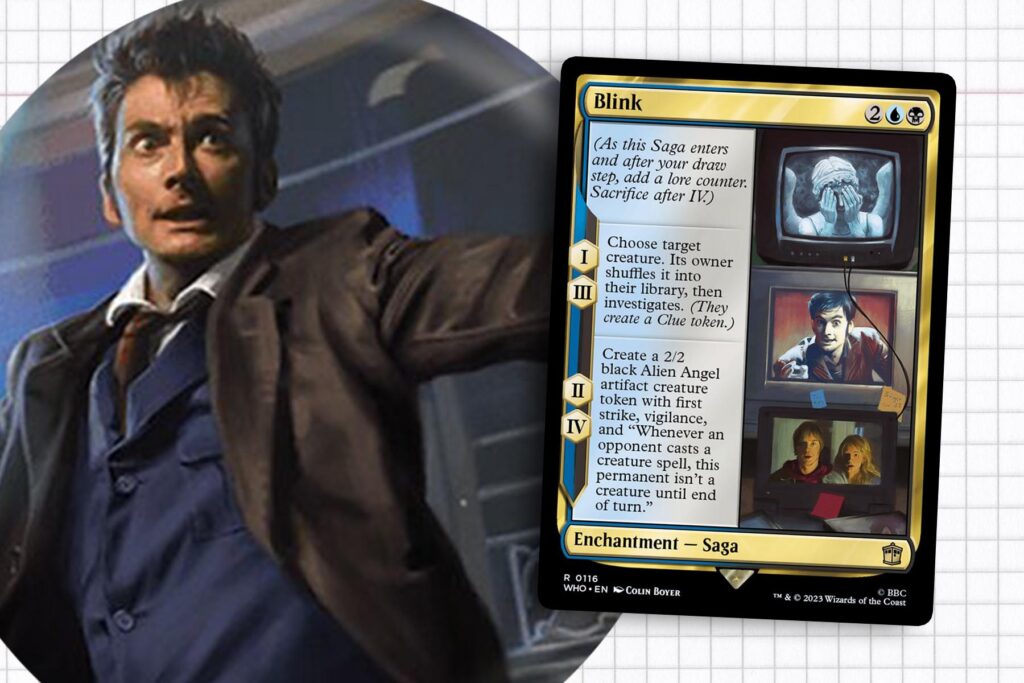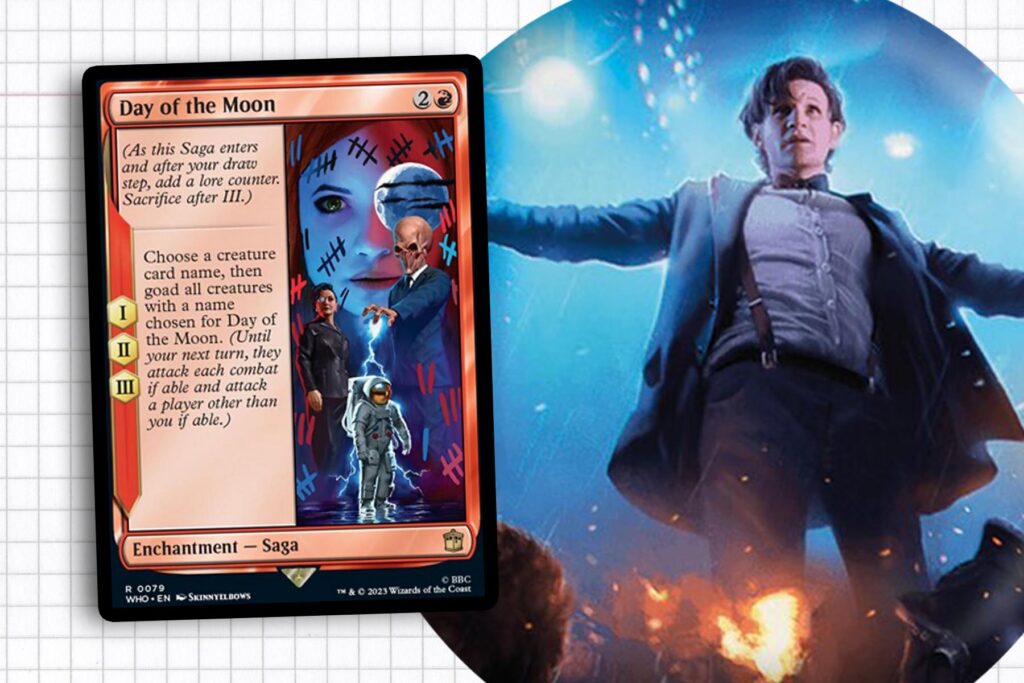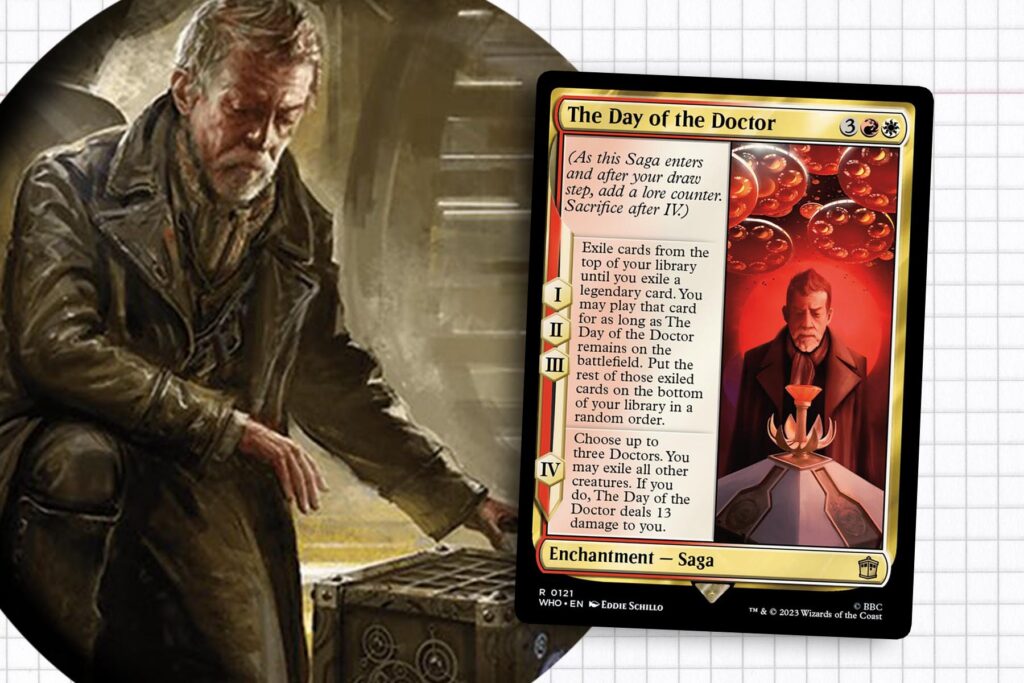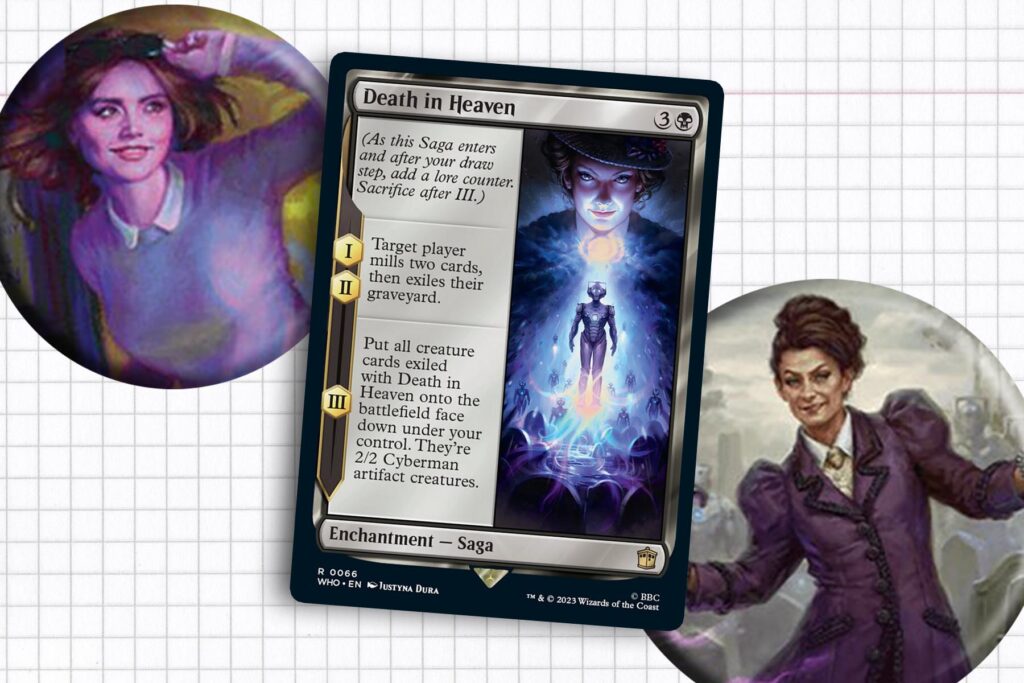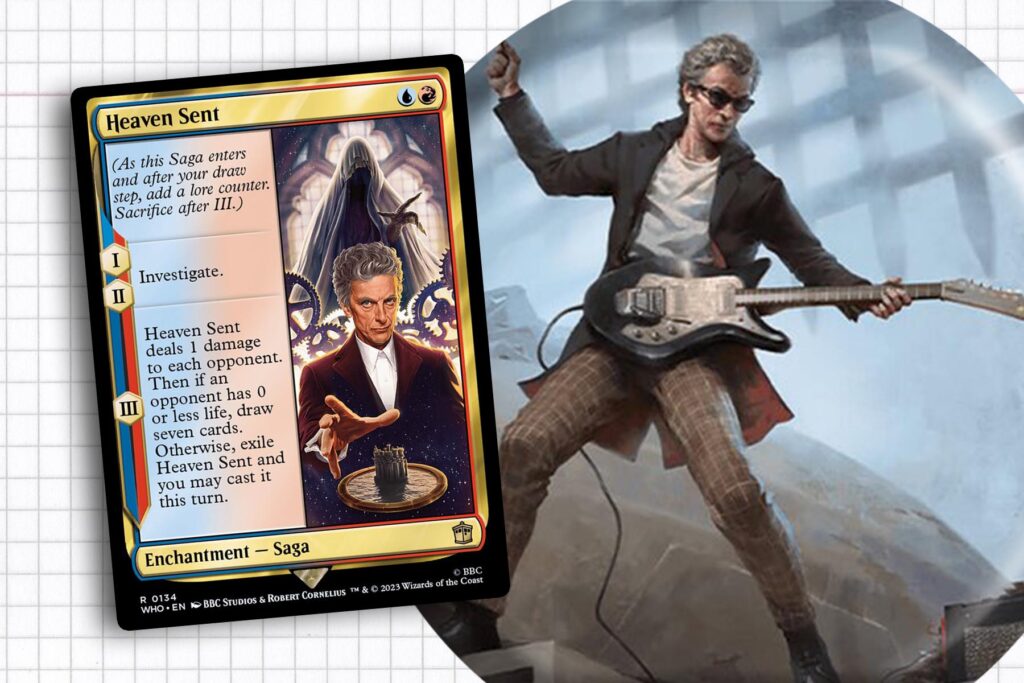As the wave of content for 2023 was announced late last year, I was reasonably skeptical about the idea of Doctor Who Commander decks. I had assumed all we would get is some Commander decks who were helmed by the different incarnations of The Doctor, but would ultimately just be filled with flavorful reskins of cards we already knew. But I have to admit I was completely wrong. As a long time fan of Doctor Who, I can see all of the heart and dedication that went into creating these products.
I found the modern era of Doctor Who in 2010, just in time to experience that year’s Christmas Special as my first piece of Doctor Who media. Taking on the classic Charles Dickens novella, with a genre twist, “A Christmas Carol” saw The Doctor try to save his friends by mending a broken heart through time travel. The stakes were huge, but the story was perfectly intimate and personal at the same time. From that I fell in love with a franchise that up until that point, I had associated mainly with nerdy adults of my parents’ generation. I would stay up to date with the ongoing adventures of The Doctor for the next several years, until I lost connection with it. Not because the stories weren’t interesting, but just because time itself became so precious.
Something that wasn’t prepared for going into the previews was just how much of the actual stories were being captured within the set’s sagas. Which is why today, in an effort to try to help Hipsters of the Coast cover this set from as many different angles. I have the pleasure of sitting down and providing you with the cliff notes version of several of the notable stories from Doctor Who history that have been captured on these sagas, while also evaluating how the mechanics did or did not properly translate.
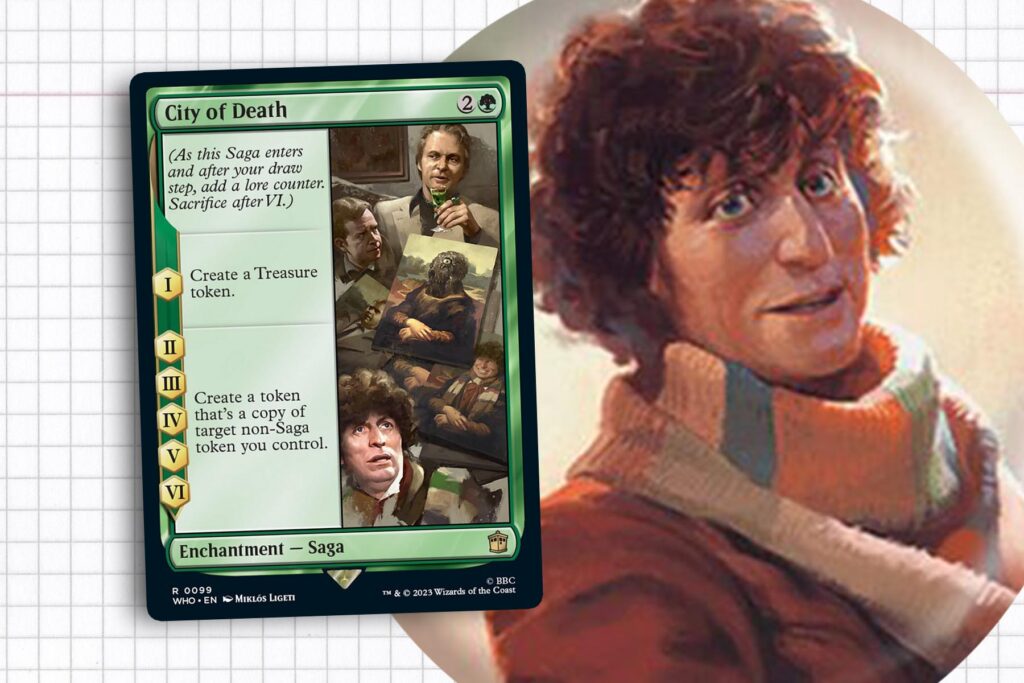
City of Death
Touted by many classic Who fans as one of the best of the era, and the only story of the classic era I’ve been able to watch in its entirety, City of Death is a four-part story in which The Fourth Doctor investigates someone who is meddling with time. Over the course of these adventures we see the Mona Lisa stolen in an effort to finance time travel experiments and ultimately learn that an alien race founded our planet 400 billion years ago.
For as long of a story this entry is, and as convoluted as it could be, I think the mechanics of what is important to the story do come across once you understand the context a bit more. Flavorfully, the Mona Lisa is the treasure in question within the confines of this card, and the duplication of tokens is tied into the fact that at some point during the story we discovered how Leonardo da Vinci painted seven additional copies of the famous painting in his own time. Ultimately making for a reasonable layer of the story into cardboard.
Blink
Blink may be one of the best Doctor Who stories, simply because it is a great candidate for being a story that you could show to anyone with zero context as to what Doctor Who is and still get a compelling arc. The 45-minute episode could have just as easily been a standalone short film, following countless main characters. The story follows Sally Sparrow, as she investigates a house that has been overtaken by the Weeping Angels, the monsters that make their premiere in this story. Over the course of the story she realizes, with the help of The Tenth Doctor, that the statues that occupy the grounds of the house are actually alien beings that are locked in place as long as someone is looking at them, but that can move extremely fast and feed off the remaining time energy of their victim’s life, typically seen by transporting the person back through time and space several decades.
This is captured through the saga by having creatures shuffled the way into their respective libraries, only to leave behind clues of what actually occurred. And ultimately once the Weeping Angels have made their presence known, the objective becomes overcoming them and occasionally placing them into stasis. This is also the story where we get the Wibbly-wobbly, Timey-wimey quote, to help explain how the perception of time works. Overall, it is a great story that I highly recommend to anybody who is looking to dip their toe into the franchise, only slightly beating out Series Four’s fantastic tenth episode, “Midnight”.
Day of the Moon
Day of the Moon has the prestigious honor of being one of my favorite stories while also being admittedly a giant convoluted mess in some respects. The story picks up in the second episode of Series 6 as The Eleventh Doctor and his companions, Amy Pond, Rory Willaims, and River Song, investigate an alien religious order, called The Silence, who have secretly overtaken the Earth for centuries. Taking visual inspiration from Edvard Munch’s painting The Scream, this alien race has the profound ability to only be remembered when you’re looking at them. Meaning that the second you take your gaze off them, you have no memory of ever seeing them.
And I only admit when I first read the card I was confused as to how the mechanics overlapped with what actually happens in the story. But then I remembered The Silence also have strong abilities for psychic suggestion, basically meaning they can “Inception you” during the brief period of time you are looking upon them. Suddenly goad made a lot of sense. The clever ending to the story is that The Doctor splices in a clip of a Silence stating that the human race should eradicate them all on sight into the Apollo 11 Moon landing footage. Meaning that for all of time, the human race will look upon this footage and unknowingly be instructed to hunt down The Silence.
The Day of the Doctor
I was lucky enough to be a fan of Doctor Who during the time of the 50th Anniversary special, a.k.a. The Day of the Doctor. The story sees the then-previous and current doctors, The Tenth Doctor and The Eleventh Doctor, crossing paths with an incarnation that, up to this point, the fanbase had been unaware of, besides a very quick cameo in the final moment of the previous story leading into this, “The Name of the Doctor”. Played by the late William Hurt, The War Doctor is the incarnation that existed between the time of The Eighth Doctor and The Ninth Doctor, as the incarnation who fought in the Time War. An event strongly hinted about for much of the modern era of Doctor Who.
Much of the special is occupied by The War Doctor slowly coming to grips with the fact that in order to end The Time War, he will need to use a powerful weapon called The Moment and eradicate their home planet of Gallifrey. Tensions arise as the two later incarnations of The Doctor look upon The War Doctor with contempt, knowing the level of destruction and loss of life that are on his hands, though they don’t precisely remember what he did. Blame that on the wibbly-wobbly, timey-wimey stuff.
The three do eventually save the day, in a very clever way but, as the final chapter of this saga alludes, it does come at a price. Of the sagas we are talking about today, I understand where the designers were going and what they were trying to capture, but it might be the weakest of the designs in terms of adequately capturing the entirety of the 50th Anniversary special. Unfair as it might be for a piece of cardboard to sum up 75 minutes of content. But I say that, only because it is possibly my most beloved Doctor Who story of all.
Death in Heaven
Early on in Wizard’s previews, we were shown Death in Heaven, paying homage to the finale of the eighth series of the modern era of the same name. In this story, we learn that the master plan of the antagonist, Missy, is to convert the dead of the British Isles into Cybermen. This can be seen in the card’s flavor, as graveyards are milled into, emptied, and the exiled creatures are brought into play under the owner of the saga’s control, as 2/2 artifact creatures.
Cybermen appearing almost entirely as facedown cards is also rather flavorful, as they are just an exoskeleton over an organic body, alive or dead. I suppose in some ways the Cybermen are akin to the zombies that we see in most media, in the stories of the appearing they are often treated more like a sickness that spreads, in this case more through something like nanobots then some kind of brain eating plague. But nonetheless the frightening part of the Cybermen is entirely just the fact that someone you love has now been irreversibly converted to this hive mind.
Heaven Sent
Heaven Sent is an incredible episode, the story is personal to The Twelfth Doctor, the editing is fantastic and the storytelling on display is something that may not hit you until the second time you watch it. Following the loss of Clara Oswald, The Doctor finds themselves investigating a mysterious castle, while also being slowly pursued by a shadowy figure. Akin to a one-man play, The Doctor goes through the process of grieving a loved one while also showing how extremely intelligent the character is.
For two-thirds of the run time of this episode, it’s unclear precisely how they’re going to get themselves out of this predicament until finally they reach a wall of diamond and spend the next several millennia slowly punching through it, interrupted by the shadowy figure and resetting back to their entrance into the castle. And ultimately in the end he breaks free of the prison, much like the saga will slowly but surely eventually result in your opponent being at zero life.
Moving Forward from Here
I was reasonably pessimistic when we found out that there would be a Doctor Who Magic set. And even after seeing what Wizards has done with other properties in the Universes Beyond line, I was not fully expecting just how all-encompassing this set has proven to be. Even at the time of writing, not seeing all the cards, I am deeply impressed by just how many references and characters this Universes Beyond product has been able to capture. While I know this perspective comes from loving the source material, I think this is proven to be one of the strongest products of 2023, even with my bias.
There is a strong potential I believe that I will be finding time to try to look at the legendary creatures coming out of this product as much as I can within the remainder of the year. That’s saying something because I also think The Lost Caverns of Ixalan is one of the most visually awe-inspiring sets I have seen in quite a while. I wholeheartedly assume that I will want to write that set just as much. Either way we are ending the year incredibly strong and I look forward to all the inspiration that this set and the next will bring in the coming months. Thanks for reading.
Ryan Sainio (he/him) is a Graphic Designer exploring the Commander format and Magic history on a regular basis. Notable decks that value flavorful and fun gameplay over competitively optimized decks include Shattergang Eldrazi, Doran Soul Sisters, and Chatterfang ProsBloom.
MTG Content Creator Awards 2022 nominee: Format Specialty Writing & Excellence in Writing Overall


